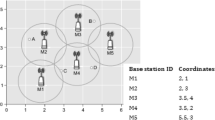Abstract
Due to the key differences between wired and ad-hoc wireless networks, traditional networking services and techniques are not always easily portable from an infrastructure based network to a wireless environment. One of the most prominent examples is the TCP transport protocol, which performs only poorly in wireless ad-hoc networks. The Peer-to-Peer (P2P) overlay networks recently developed all target the Internet where a lot of performance issues can be neglected or can be completely ignored. In addition, assumptions made for infrastructure based networks cannot be made in an ad-hoc environment, such as a fixed set of nodes which are always available. This article presents a P2P network tailored towards mobile ad-hoc environments. It utilizes proximity information to efficiently generate an overlay structure which reflects the underlying physical network topology. This way, physical routing path lengths stretched by the overlay routing process are reduced. As a novelty it does not rely on a fixed set of nodes and adapts to changes in the physical network topology. A prominent property of the overlay construction process is that the communication overhead is reduced to a minimum. Additionally, the P2P network presented maintains an even Overlay ID distribution which is deliberately given up by some solutions previously developed for wired networks. The basis of this new overlay network is Pastry, a P2P substrate based on the concept of a distributed hash table. Two different bootstrap strategies were developed and analyzed, both explicitly designed to work in dynamic and mobile networks such as ad-hoc networks.
Similar content being viewed by others
References
M. Castro et al., Exploiting network proximity in peer-to-peer overlay networks, in: Internat. Work-shop on Future Directions in Distributed Computing (FuDiCo) (2002).
D.B. Johnson and D.A. Maltz, Dynamic source routing in ad-hoc wireless networks, in: Mobile Com-puting, Vol. 353, eds. Imielinski and Korth (Kluwer Academic, Dordrecht, 1996).
Omnet++, Discrete event simulation system, http://www.omnetpp.org (2003).
C.E. Perkins, Ad-hoc on-demand distance vector routing, http://people.nokia.net/charliep/ (2003).
S. Ratnasamy et al., A scalable content-addressable network, in: Proc. of ACM SIGCOMM (2001).
S. Ratnasamy et al., Topologically-aware overlay construction and server selection, in: IEEE INFO-COM (2002).
J. Ritter, Why Gnutella cannot scale, no, really, http://www.darkridge.com/jpr5/doc/ gnutella.html (2001).
A. Rowstron and P. Druschel, Pastry: Scalable, decentralized object location and routing for large-scale peer-to-peer systems, in: Internat. Conf. on Distributed Systems Platforms, Middleware (2001).
I. Stoica et al., Chord: A scalable peer-to-peer lookup service for Internet applications, in: Proc. of ACM SIGCOMM (2001).
The Gnutella protocol specification v0.4, www9.limewire.com/developer/gnutella_ protocol_0.4.pdf (2001).
M. Waldvogel and R. Rinaldi, Efficient topology-aware overlay network, in: SIGCOMM/CCR 2003.
Z. Xu, C. Tang and Z. Zhang, Building topology-aware overlays using global soft-state, in: ICDSC'2003.
B.Y. Zhao, J.D. Kubiatowicz and A.D. Joseph, Tapestry: An infrastructure for fault-resilient wide-area location and routing, Technical Report UCB//CSD–01–1141, Berkeley (2001).
Author information
Authors and Affiliations
Rights and permissions
About this article
Cite this article
Winter, R., Zahn, T. & Schiller, J. DynaMO: A Topology-Aware P2P Overlay Network for Dynamic, Mobile Ad-Hoc Environments. Telecommunication Systems 27, 321–345 (2004). https://doi.org/10.1023/B:TELS.0000041014.05554.ee
Issue Date:
DOI: https://doi.org/10.1023/B:TELS.0000041014.05554.ee




